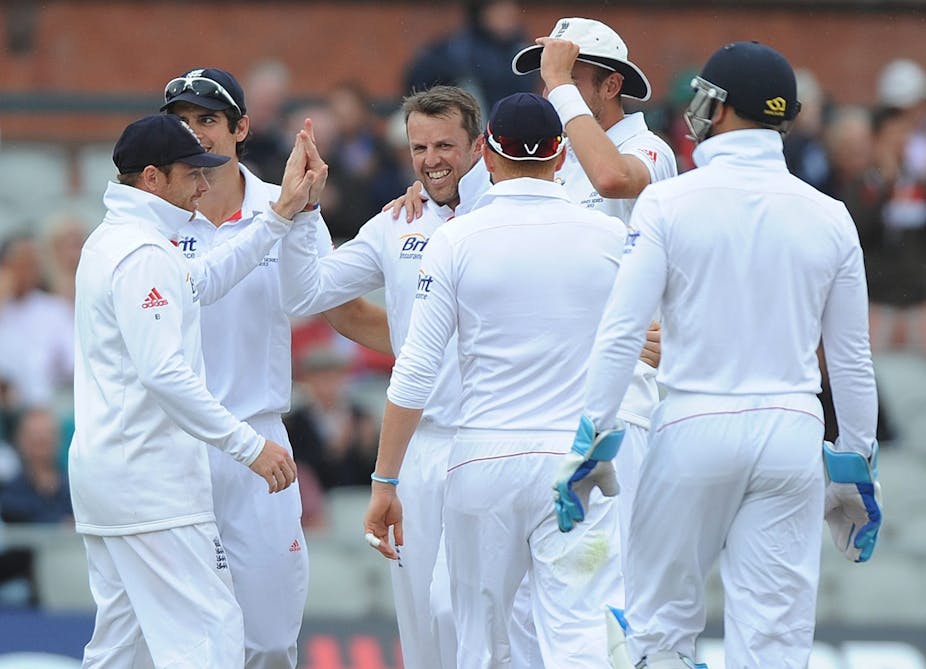The end of the English summer beckons, and Act One of the current Ashes drama is reaching its appointed denouement across the Thames from London’s Theatreland at The Oval. The interval will last until the sun also rises high on the other side of the equator in November in Brisbane.
This tumultuous season has combined the old and the new, with time-honoured Anglo-Australian rivalry colliding with very 21st century disputation over action simulation technology.
Individual cricket performances have come and gone across our television screens like shower squalls over the Pennines in northwest England, leaving behind statistical records and contested narratives. Televised sport has been revealed once more to be a curious synthesis of live theatre, outside broadcast and in-house studio production. Performers excel or fail before our eyes, but most of us were somewhere else, and so depend on camera angles selected by others to shape what we see, and on broadcast commentary to tell us what we have seen.
The game’s twists and turns are welded into coherent spectacle only as it unfolds. The script is still being drafted after the live performance has commenced. One moment, as during the washed out third Test and for much of the fourth, Australia seemed to have seized the initiative, and a new plot line of resurgence was underway. However, the clatter of falling wickets followed by defeat at Durham demanded an instant re-write along the lines of a false dawn or a dead cat bounce.
Media corporations are willing to pay very large sums to acquire the rights to live sport because of this very unpredictability and immediacy. Sport is one of the few forms of regular programming – apart from the reality TV confection that has increasingly imitated it - where the live broadcasting of history can be witnessed. Pivotal live sporting moments cannot be conveniently time-shifted or boxed for DVD viewing binges. They are all about the now – and popular real-time drama comes with a hefty price tag.
But if this is to be a price worth paying viewer attention is essential in order to maintain the healthy economy of the eyeball. Because live sport’s many large and small outcomes cannot be reliably predicted, spectator appeal must be primed and retained even if the events on the field fall short.
It is for this reason that athletes are turned into thespians, coaches into auteurs, and administrators into executive producers. There are plots and sub-plots, dramatic sequences and pauses, and characters with admirable qualities or malign intents. Because this rather bizarre spectacle has to be pitched at a high emotional register to draw in even those who barely understand it, the governing genre is melodrama, with notes of pantomime and farce.
Television sport isn’t generally classified as drama alongside the likes of Downtown Abbey and Underbelly, but it unquestionably lives and dies by its dramatic potential. Its principal narrative tension lies in the enduring conflict between competitive nobility and the ethical holiday of win-at-all-costs. A Greek chorus of commentators draws the necessary moral conclusions – but generally, like the teams, from the viewpoint of opposing sides.

Roles are assigned along conventional principles of archetype. For example, the dashingly heroic character played by England captain Alastair Cook can be drawn to contrast with his villainous teammate Stuart Broad, whose barefaced refusal to walk when obviously out revealed the ruthless streak of the congenital cad. Similarly, the immodest strutting of English batsman Kevin Pietersen may be neatly offset by the Dickensian humility of his Australian opponent Nathan Lyon.
Large-scale themes might also be introduced, such as one based on the back-breaking injuries of social class. Brawny fast bowlers like Australia’s James Pattinson and Englishman Tim Bresnan can play the proletarians mightily labouring, frequently in vain, to supplant the aristocratic elegance and languid foppery of batting stylists Ian Bell (the series’ leading runscorer) and Australian captain Michael Clarke.
Or the troubling body versus machine question, with its haunting spectre of technology rendering the human factor obsolete, might be evoked in the application of a battery of visualisation methods to legitimise or overrule the evidence of the unassisted eye. Here a nightmare world is portrayed, more Bladerunner than Howard’s End, where human inventions have turned on their inventors, aided and abetted by the unseen prosthetic hand of the mysterious third umpire.
The mise-en-scène extends far beyond the pitch. Transgressive offstage conduct is duly referenced, such as David Warner’s Birmingham nightclub swing at his fake-bearded opponent Joe Root, or Monty Panesar’s Graham Greenesque urination over bouncers on a Brighton seafront. The impetuosity of such public drunkenness constructs a rambunctious anti-hero figure who throws into sharp relief the soberly calculating bat-tamperer, secretly thwarting Hot Spot technology unseen by the camera phones of the night.
Such real and imagined displays of mortal weakness manicure the moral landscape of Ashes cricket. The next instalment of this allegory of glove will continue after a short intermission in deference to the revenue requirements of its impresarios, Cricket Australia and the England and Wales Cricket Board.

